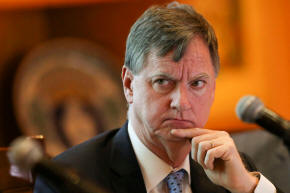|
"I
think front-loading is important to speed up the necessary
tightening of financial conditions, as well as for demonstrating
our commitment to restrain inflation, thus helping to keep
inflationary expectations in check," Evans told the Money
Marketeers in New York, noting that inflation is "much too
high."
The Fed has raised interest rates by three-quarters of a
percentage point so far this year, including a bigger-than-usual
half-point hike earlier this month that lifted short-term
borrowing costs to a range of 0.75%-1%.
Fed Chair Jerome Powell has signaled at least two half-point
rate hikes are ahead. On Tuesday he told the Wall Street Journal
that the central bank will keep "pushing" on rate hikes until it
sees inflation move down in a "clear and convincing way," not
hesitating to move more aggressively if that does not happen.
Rates will likely need to go above neutral, Evans told
reporters, but pushing them there makes him "nervous," in part
because it's difficult to know exactly when rates will start to
bite into growth, and other risks could suddenly emerge.
So rather than barreling ahead at half-point jumps, Evans wants
to go more slowly.
"I do expect that July, September, we'll be talking about that,"
Evans told reporters after his address. By December, he said, he
expects "we will have completed any 50 (basis point hikes) and
have put in place at least a few 25 (basis point hikes)."
That slower pace would give the Fed time to check if supply
chain kinks ease, and to evaluate inflation dynamics and the
impact of higher borrowing costs on what he called a "downright
tight" labor market. Unemployment is at 3.6% and job openings
are at a record high.
"If we need to, we will be well positioned to respond more
aggressively if inflation conditions do not improve sufficiently
or, alternatively, to scale back planned adjustments if economic
conditions soften in a way that threatens our employment
mandate," Evans said.
Prices in futures contracts tied to the Fed's policy rate
reflect expectations for an end-of-year policy rate range of
2.75%-3%, and for rate hikes to top out in the 3%-3.25% range.
Critics including several former U.S. central bankers have
recently warned that the Fed, by waiting too long to raise
rates, has set up the economy for a recession.
"Given the current strength in aggregate demand, strong demand
for workers, and the supply-side improvements that I expect to
be coming, I believe a modestly restrictive stance will still be
consistent with a growing economy," Evans said.
(Reporting by Dan Burns; Writing by Ann Saphir; Editing by
Richard Pullin)
[© 2022 Thomson Reuters. All rights
reserved.]
This material may not be published,
broadcast, rewritten or redistributed.
Thompson Reuters is solely responsible for this content.

|
|





